AMD's Richland vs. Intel's Haswell GPU on the Desktop: Radeon HD 8670D vs. Intel HD 4600
by Anand Lal Shimpi on June 6, 2013 12:00 PM ESTCompute
As always we'll start with our DirectCompute game example, Civilization V, which uses DirectCompute to decompress textures on the fly. Civ V includes a sub-benchmark that exclusively tests the speed of their texture decompression algorithm by repeatedly decompressing the textures required for one of the game’s leader scenes. While DirectCompute is used in many games, this is one of the only games with a benchmark that can isolate the use of DirectCompute and its resulting performance.
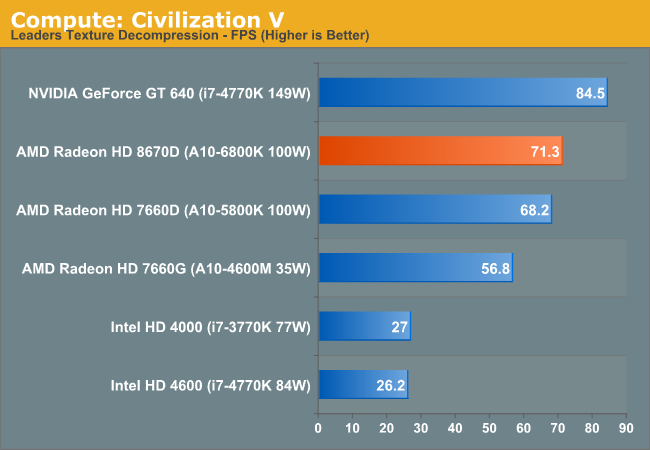
AMD does extremely well in our sole DirectCompute test, outperforming Intel's latest desktop graphics solution by a huge margin.
Our next benchmark is LuxMark2.0, the official benchmark of SmallLuxGPU 2.0. SmallLuxGPU is an OpenCL accelerated ray tracer that is part of the larger LuxRender suite. Ray tracing has become a stronghold for GPUs in recent years as ray tracing maps well to GPU pipelines, allowing artists to render scenes much more quickly than with CPUs alone.
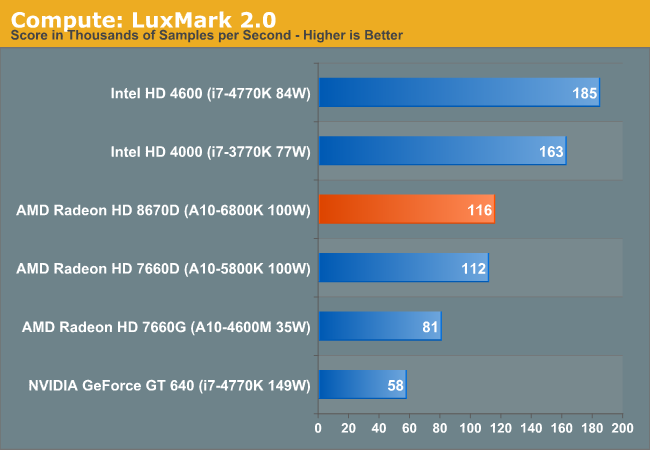
Haswell GT2's OpenCL performance can be very good, which is what we're seeing here. HD 4600 ends up being almost 60% faster than the Radeon HD 8670D.
Our 3rd benchmark set comes from CLBenchmark 1.1. CLBenchmark contains a number of subtests; we’re focusing on the most practical of them, the computer vision test and the fluid simulation test. The former being a useful proxy for computer imaging tasks where systems are required to parse images and identify features (e.g. humans), while fluid simulations are common in professional graphics work and games alike.
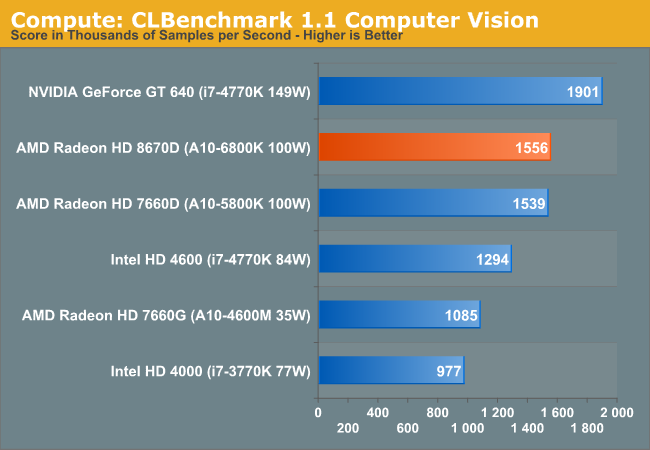
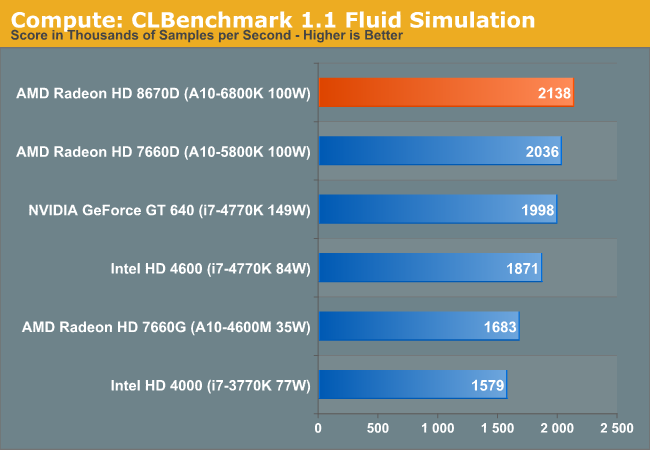
AMD and Intel trade places once again with CLBenchmark. Here, Richland does extremely well.
Our final compute benchmark is Sony Vegas Pro 12, an OpenGL and OpenCL video editing and authoring package. Vegas can use GPUs in a few different ways, the primary uses being to accelerate the video effects and compositing process itself, and in the video encoding step. With video encoding being increasingly offloaded to dedicated DSPs these days we’re focusing on the editing and compositing process, rendering to a low CPU overhead format (XDCAM EX). This specific test comes from Sony, and measures how long it takes to render a video.
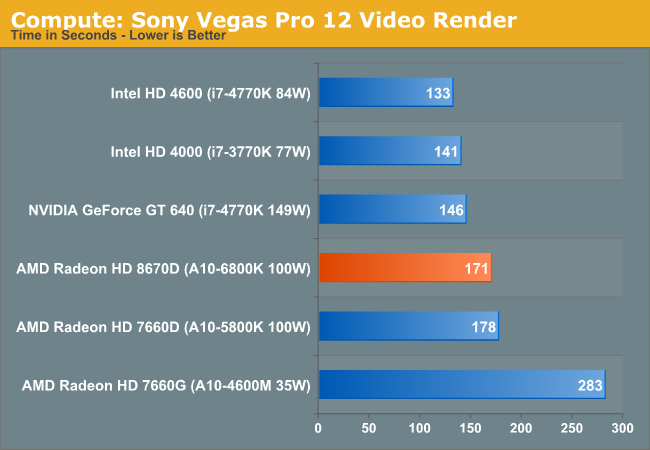
The last compute test goes to Intel, although the two put up a good fight across the entire suite.










102 Comments
View All Comments
mrSmigs - Friday, June 7, 2013 - link
It still amazes me that websites bench the i7s vs the amd a10 platforms. Whole a10 systems can be purchased for the price of an i7 CPU. Why dont you test a $200 graphics card in an a10 system vs the i7 integrated graphics - if this is the case and show people what they can get (for their $350 dollars spent on cpu + graphics)???? The closest price processor from intel vs 6800k that i found locally was an i3 3240. Why dont you use these in the comparisons?????? Why use a Gt640 only with an i7 & not on the amd system to show the cpu bias in the benches???DeviousOrange - Friday, June 7, 2013 - link
While yes the i7 being the fastest mainline part available and x86 will help distort its numbers a bit nevertheless the issue is not x86, the issue is iGPU performance only. That being said the i7 4770K and A10 6800K are both the top line parts in review so there is no ambiguity as to one being entry level and the other top line, these are both flagships so the test is top product on top product iGPU showdown.What is disappointing is Anandtech still don't have any workable Frame Scaling tool to asses performance as Frames Per Second means diddly squat where Frame Latency is the true indicator. As before the A10 is always below 10ms and often below 1ms while the i7's HD4600 often hits 60ms+ latencies which is basically a microstut.tut.tut.tut.tut.ter.
I haven't personally tested HD4600 but I have been told it has boosted FPS but in terms of frame transistions which are often a combination of hardware and driver support that HD4600 is not much better so again while HD4600 is close in FPS in some instance, its very far off in latency. In short I would rather have a iGPU average 27FPS but have 0.1ms latencies opposed to 35FPS with 50ms latencies.
mrSmigs - Friday, June 7, 2013 - link
The comparison is amd's budget apu line vs intels top desktop line. You should throw a radeon 7850 in the amd system to even up the specs (at least dollars wise) and then run a few graphics benches... please someone do a comparison i7-4770k with its iGPU vs a10-6800k+7850hd in gaming. im pretty sure i could guess the winner here...sireangelus - Friday, June 7, 2013 - link
Just think about the performance of a i74770KR... 128 mb of L4 cache, an amount to put to shame any serverPhiro69 - Friday, June 7, 2013 - link
" AMD is proud of its valiation on the A10-6800K" - you mean validation, right?halbhh2 - Friday, June 7, 2013 - link
While it is interesting to see gaming benches, since I might game on an HTPC, I'm actually thinking more on how perfectly the chips can display a 4K video, *and* I'm interested in whether I can run 2 HD movies (two at once) on 2 displays without any dropped frames or stutters (this actually matters a bit at the moment for me). I know there is one article here for the Intel 4600 graphics re 4K.hobagman - Saturday, June 8, 2013 - link
Anand, I think this is a waste of time. I don't know anybody who buys desktops anymore, unless they intend to use it as a workstation or as a gaming platform. In the first case, they don't usually care about graphics, and in the second case, they will absolutely have discrete graphics and these graphics benchmarks are utterly irrelevant. I like this website and appreciate the work, but I would rather you spend your time on something more useful for us -- for example, comparing the notebook platform integrated graphics would be reasonable. This article puzzles me.fteoath64 - Saturday, June 8, 2013 - link
"comparing the notebook platform integrated graphics would be reasonable.". There are many reviews about IGP for the APUs for specific users or gamers. This article highlights how much AMD has arrived in terms of gpu and cpu balance in their desktop and notebook parts (ie APUs specifically) which will pose a serious challenge to Intel's dominance. To many, Intel based cpu with IGP is clearly not the way to go only Intel cpu plus Nvidia discrete gpu or go the APU route and compromise cpu somewhat gaining close to discretely gpu performance for way less money.Also shows that Intel 4600 IGP has gone a long way to within striking distance of AMD APU gpus but not good enough as the sliding scale of reference MOVES each time Intel approaches. The GT3e potentially can match a NV 650M discrete but at the cost of Intel $$$ to the user. Most manufacturers rather go Nvidia discrete which is cheaper and better as well. So unless Intel goes into heterogeneous core architecture chips for cpus, there is nothing really new in their offering.
zyky - Saturday, June 8, 2013 - link
With the dozens of different configurations that call themselves "GT 640" It's pretty important to specify which one was used in these tests. GF116? GK107? GK208? GDDR3? GDDR5?Ryan Smith - Tuesday, June 18, 2013 - link
There's only one retail GT 640 (as of this article); the GK107 based DDR3 version.